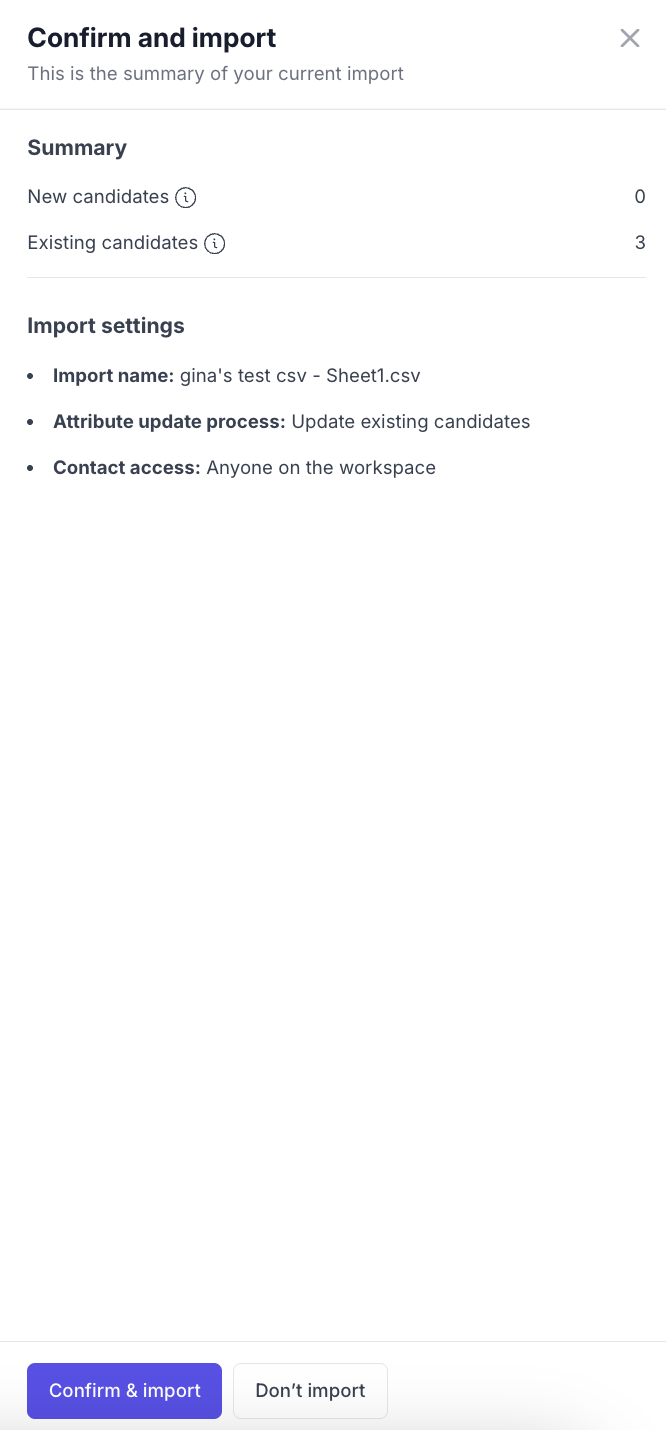Table of Contents
Importing Candidates
Updated
by Gina Romero
Importing Candidates
Learn how to bulk upload candidates into your database or directly into a study using a CSV file.
Who This is For
This guide is for:
- Admins and Creators managing participant databases
- Researchers recruiting participants for upcoming studies
- Ops teams maintaining panel data accuracy
What You’ll Learn
By the end of this article, you’ll know how to:
- Prepare your data for import
- Bulk upload candidates into Great Question
- Map attributes and update existing profiles
- Import candidates directly into a study
Before You Import
To ensure your import runs smoothly, make sure your file meets the following requirements:
- File format — Must be a CSV file (
.csv). - Headers — Column headers must appear in the first row.
- Unique identifiers — Each row must include a valid email address (or another unique field if enabled).
- Clean your data —
- Remove stray or invisible characters.
- Fix unescaped quotation marks (
"NYC"instead of“NYC). - Check for misaligned headers.
- Remove duplicates, empty rows, and unnecessary columns.
How to Import Candidates
You can import candidates from either the Candidates page or directly within a study.
Option 1: Import to the Candidates Page
- Navigate to the Candidates page in the left-hand menu.
- Click Add candidates.
- If your database is empty, you’ll see this option under Build your research panel.
- If you already have candidates, it appears in the top-right corner.
- Select Import from CSV.
- Upload your file by dragging and dropping or using your file browser.
- Review and map fields under Review import.
- Great Question automatically matches your CSV columns to existing attributes.
- If a field doesn’t exist, type a name and click Save this as a new attribute.
- Uncheck any columns you don’t want to include.
- Adjust Import settings:
- Import name – defaults to your file name (you can rename).
- Candidate update process - whether this import will or will not update candidate attributes.
- Contact Access– assign team access or unique identifiers.
- Shortlist to a study (optional) – automatically add these candidates to a published study.
- Unique identifier - using email is the default, but can be switched if necessary (reach out to Support for access)
- Bulk attribute (optional) – apply a label or tag to all imported candidates.

- Click Review & import to confirm the details in the slide-out panel.
- Click Confirm & import.

You’ll see a confirmation message. Smaller imports process instantly; larger files (up to 10K rows) may take a few minutes. We recommend doing 10k at a time. You’ll also receive an email when the import finishes.
Option 2: Import Candidates Directly to a Study
- Open the study where you want to add candidates.
- Click Add candidates → select Import from CSV.
- Upload your file using drag-and-drop or the file browser.
- Map your fields as described above.
- Since you’re importing from within a study, all candidates will be shortlisted automatically to that study (and added to your main database). If you’re not seeing them in the shortlist, it’s possible they already exist in the study under a different list—such as Invited, Removed, or another status.
- Review and confirm your import.
Once complete, the candidates will appear in your Participants tab under Shortlisted and will be available for recruiting or screening.
How to Troubleshoot Importing Candidates
If something goes wrong during your import, review the common issues below to quickly identify and fix the problem.
Issue | What's Happening | How to Fix It |
File upload failed | The file isn’t in | Save your file as a |
Import is stuck or taking too long | Large files (10,000+ rows) can take extra time to process. | Split the file into smaller batches and re-upload. You’ll receive an email confirmation once processing completes. |
Columns aren’t matching correctly | CSV headers don’t match existing attributes in Great Question. | Review field mapping and create new attributes during the Review import step if needed. |
Duplicate candidates skipped | Import settings are set to skip duplicates. | Choose Update existing candidates during import to overwrite existing records instead. |
Some rows didn’t import | Missing or invalid email addresses or unique identifiers. | Add valid emails or unique IDs to each row and re-upload. |
Special characters appear incorrectly | The CSV isn’t encoded in UTF-8 format. | Re-export your file using UTF-8 encoding before importing. |
New attributes not appearing | The new field hasn’t refreshed in the system. | Refresh your browser or check Settings → Custom attributes → Candidate attributes to confirm creation. |
Candidates not appearing in study | Candidates were imported to the database only (not shortlisted) or they already exist within the study. | If importing from the Candidates page, enable Shortlist to a study or import directly from the study. If you’re not seeing them in the shortlist, it’s possible they already exist in the study under a different list—such as Invited, Removed, or another status. |
Incorrect data under attributes | Columns were mismatched during mapping. | Re-import your file and review the mappings carefully before confirming. |
Did not receive confirmation email | Email notifications are disabled or filtered. | Check spam/junk folders or enable email notifications in your settings. |
Have Questions?
Please reach out to us in the chat or at [email protected]!
